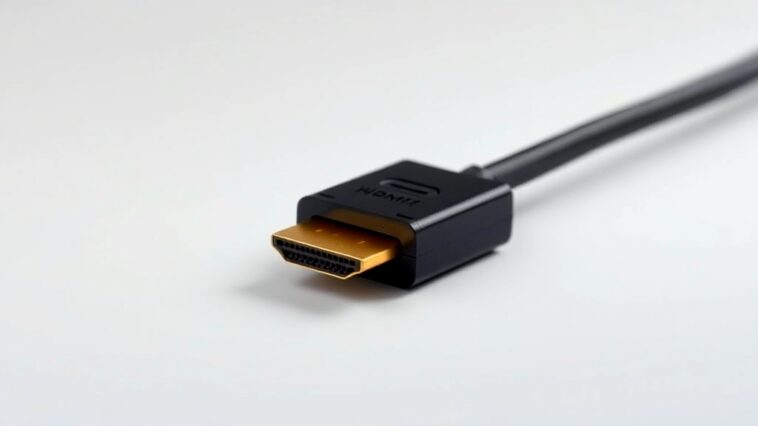Alright, let’s dive into the world of HDMI 2.1! If you’re anything like me, you might have found yourself scratching your head when hearing about HDMI specifications. You know how it is—there are so many numbers and letters thrown around, it feels like you need a decoder ring just to keep up. But don’t worry! In this article, we’re going to unravel the mystery behind HDMI 2.1, its benefits, features, and why upgrading might just be the best decision you make for your home entertainment system or gaming setup.
What is HDMI 2.1?
To kick things off, let’s get a basic understanding of what HDMI 2.1 is. The High Definition Multimedia Interface (HDMI) is a standard that carries both audio and video signals from a source device to a display. The 2.1 HDMI standard, which was released in late 2017, is the latest iteration and brings a whole bunch of improvements over its predecessor, HDMI 2.0.
HDMI Specifications at a Glance
- Bandwidth of 48 Gbps: This is a game changer! It allows for higher resolutions and refresh rates.
- 8K video capability: Yes, you heard that right—8K. But hold on; that’s not all.
- Dynamic HDR: This means every frame can have its own HDR settings.
- Variable Refresh Rate (VRR): Perfect for gaming, it reduces screen tearing.
- Enhanced Audio Return Channel (eARC): This helps in delivering high-quality audio back to your sound system.
And that’s just scratching the surface!
Benefits of HDMI 2.1 for Gaming Consoles
So, why should gamers get excited about HDMI 2.1? Honestly, I think it’s a pretty big deal. For one, HDMI 2.1 for gaming consoles is a match made in heaven. If you’re the proud owner of a PlayStation 5 or an Xbox Series X, you’re going to want to pay attention.
Key Features for Gamers
- 4K Video Support: With support for up to 4K at 120 frames per second, gameplay is smoother than ever.
- Quick Frame Transport (QFT): This feature minimizes latency, meaning you can react faster in your games. Ever had that moment when you just miss the perfect shot? This can help!
- Auto Low Latency Mode (ALLM): Your TV will automatically switch to low-latency mode when gaming, ensuring you have the fastest response times.
HDMI 2.1 vs HDMI 2.0 Compatibility Issues
Now, you might be wondering—what about HDMI 2.1 vs HDMI 2.0 compatibility issues? It’s a valid concern. If you’ve got older devices, you might be thinking, “Will this new stuff even work with what I already have?”
Well, here’s the scoop: HDMI 2.1 is backward compatible with HDMI 2.0 devices. But here’s the catch—your older HDMI cables and devices won’t support the full capabilities of HDMI 2.1. So, if you’re playing a game that pushes the limits of 4K resolution and high refresh rates, you won’t get that smooth experience unless everything in your setup is compatible.
Setting Up HDMI 2.1 for 4K Gaming
Setting up your HDMI 2.1 for 4K gaming is easier than you might think. But, like anything, it could have its hiccups—of course, because nothing ever goes smoothly, right? Here’s a quick guide to help you out:
- Check Your Devices: Make sure your TV, console, and HDMI cables support the HDMI 2.1 standard.
- Use the Right Cables: Invest in best HDMI 2.1 cables for ultra-high-definition TVs. Look for cables rated for 48 Gbps bandwidth.
- Optimal Settings: Go into your TV settings and make sure all the HDMI ports you’re using are set to enable 4K/120Hz and HDR.
Once you set this up, you might just find yourself immersed in gaming like never before—it’s kinda hard to go back once you experience it!
HDMI 2.1 Features Explained for Home Theater Systems
Now, if you’re more of a movie buff than a gamer, don’t worry. HDMI 2.1 has features that cater to home theater systems too. HDMI 2.1 features explained for home theater systems include:
- Dynamic HDR: This brings your movies to life with stunning visuals, adjusting HDR settings per frame.
- eARC: The Enhanced Audio Return Channel allows for high-quality audio formats, ensuring your sound system can deliver exactly what the director intended.
Imagine watching a movie and having the sound envelop you from all directions. It’s an experience that enhances every moment.
Troubleshooting HDMI 2.1 Connection Problems
But, what if things don’t go as planned? Troubleshooting HDMI 2.1 connection problems is something everyone dreads. Here are some common issues and quick fixes:
- No Signal: Check if the HDMI cable is securely connected. Sometimes, it’s just a loose connection.
- Screen Flickering: This might indicate cable issues. Make sure you’re using high-speed HDMI cables rated for 48 Gbps.
- Audio Issues: If you’re not getting sound, double-check your audio settings on both the TV and the source device.
Honestly, I’ve had my share of “What now?” moments while setting up my system. The trick is to stay calm and methodical.
Upgrading to HDMI 2.1: Is It Worth It?
Here’s a question you might ask yourself: Is upgrading to HDMI 2.1 worth it? Well, let’s break it down.
If you’re planning to invest in a new TV or gaming console, the answer is a resounding yes. The features offered by HDMI 2.1, such as dynamic HDR, 8K video capability, and VRR, are what future-proofing your setup is all about. At the end of the day, don’t you want your system to be ready for whatever comes next?
Future-proofing Your Setup with HDMI 2.1 Specifications
Let’s talk about future-proofing your setup with HDMI 2.1 specifications. The world of tech moves fast—what seems cutting-edge today might be outdated tomorrow. So, investing in HDMI 2.1 means you’re preparing for the next wave of technology.
- 12-bit color depth: This allows for richer colors and better contrast, which will be essential as displays continue to evolve.
- 8K video capability: As more content becomes available in 8K, you’ll be glad you made the jump.
HDMI 2.1 Gaming Monitors: What to Look For
If gaming is your jam, you might be considering an upgrade to an HDMI 2.1 gaming monitor. But what should you look for? Here are some tips:
- Refresh Rate: Look for monitors that support 120Hz or higher.
- Response Time: A lower response time (1ms or less) will improve your gaming experience.
- Adaptive Sync Technology: Features like G-Sync or FreeSync can further enhance gameplay.
You want a monitor that not only displays beautifully but also keeps up with fast-paced action. Trust me; it makes a difference.
How HDMI 2.1 Enhances VR Gaming Experiences
And for those of you into VR gaming, how HDMI 2.1 enhances VR gaming experiences is something worth noting. The high bandwidth of HDMI 2.1 allows for:
- Higher resolutions and frame rates, which can create a more immersive experience.
- Low latency, crucial for VR gaming where every millisecond counts to avoid motion sickness.
Getting that extra edge in VR can be a game-changer—literally!
Comparison of HDMI 2.1 Features Across Different Brands
But, not all HDMI 2.1 implementations are created equal. A comparison of HDMI 2.1 features across different brands can shed some light on what to expect:
- LG: Their OLEDs usually come with robust support for HDMI 2.1 features making them a top choice for gamers.
- Samsung: Known for their QLED technology, they often have great implementations of eARC and dynamic HDR.
- Sony: With their gaming-centric features, they are great for PlayStation users.
Always be on the lookout for reviews and user feedback. It’s worth doing your homework.
Understanding eARC with HDMI 2.1 for Sound Systems
Finally, let’s touch on understanding eARC with HDMI 2.1 for sound systems. This feature is a game-changer for anyone who takes audio seriously.
With eARC, you can send high-quality audio formats like Dolby Atmos and DTS:X back to your sound system without losing quality. This means your movie nights will sound better than ever before—like a mini-theater experience in your living room.
Conclusion: Embracing the Future with HDMI 2.1
At the end of the day, embracing HDMI 2.1 is about more than just the numbers; it’s about enhancing your overall experience—whether that’s gaming, binge-watching your favorite shows, or hosting movie nights. And let’s be real, who doesn’t want a setup that’s ready for the future?
So, are you ready to upgrade? With the benefits it brings, from gaming consoles to home theater systems, HDMI 2.1 is definitely worth considering. So, go ahead—give your home entertainment setup the upgrade it deserves. You won’t regret it!
Other Related Articles
- Eizo Foris FS2331 Review
- How Much Power Does a 144Hz Monitor Use? A Deep Dive into Energy Consumption
- Should I Turn On HDR for Gaming? A Comprehensive Guide
- Is iPhone 16 Pro OLED the Best Display Yet?
- Understanding Panel Variance: What It Means for Your Monitor Purchase
- Can You Throw Computer Monitors in the Trash? The Ultimate Guide to Eco-Friendly Disposal
- Understanding VESA ClearMR: The Future of Motion Clarity in Displays
- 4K vs 1080p – Is UHD Worth The Upgrade?
- How To Choose The Right Gaming Monitor: A Comprehensive Guide
- IPS vs OLED Monitors for Color Accuracy: The Ultimate Showdown
- HDMI 2.1: The Future of Home Entertainment and Gaming
- How to Connect Heart Rate Monitor to PC?
- Curved vs Flat TV – Which Should You Choose? The Ultimate Showdown for 2025
- Can You Connect M-Audio Monitors to PC?
- Why Is My PC Showing the Same Display on Two Monitors?
- Why Are Computer Monitors More Expensive Than TVs?
- The Best Flicker-Free Monitors for Eye Care
- Monitors for Mac vs Windows PCs: The Ultimate Showdown
- 1920×1080 vs 2560×1440 – Which One Should I Choose?
- 99219444 Toshiba and Its Revolutionary Features for Tomorrow’s Tech Landscape
- OLED vs QD-OLED: The Showdown of Display Technologies
- What Is DisplayPort 2.1?
- What Is The Best Monitor Size For Gaming?
- 720p vs 1080p vs 1440p vs 4K vs 8K – Which Should I Choose?
- Is An HDR Gaming Monitor Worth It?
- Mini-LED vs MicroLED: What’s the Difference?
- Do Pawn Shops Take Computer Monitors?
- What LG Computer Monitor is as Good as the C3?
- Understanding Pixel Walk and Pixel Inversion
- Curved vs Flat Monitors for Work: Which One is Right for You?
- What Is The Soap Opera Effect?
- 4K vs 1440p Monitors for Video Editing: Which One Should You Choose?
- Do I Have to Attach a Hood to My BenQ Monitor?
- Can You Use Mac as a Monitor for PC?
- What Is G-SYNC And What Does It Do?
- Daz Studios Summoner G8 for the Visionary Artist
- Dell vs HP Monitors for Gaming
- Understanding IPS Technology: A Comprehensive Guide
- 27-Inch Monitors vs 32-Inch Monitors for Productivity
- Understanding Screen Resolution: Why It Matters for Your Displays
- How to Transport Computer Monitors?
- How to Dispose of Computer Monitors?
- What Is 4K Resolution And Is It Worth It?
- How to Pack Computer Monitor for Moving?
- What Is HDR For TVs And Is It Worth It?
- 1440p or 144Hz – Which Is Best For You?
- USB Type-C Explained – Everything You Need To Know
- Samsung’s Exciting Journey into Glasses-Free 3D Displays at Gamescom 2024
- I Have A Problem with My Samsung Odyssey G3 Monitor Setup
- Is A 144Hz Monitor Worth It? A Comprehensive Guide
- Understanding FALD Blooming and the Halo Effect: A Deep Dive
- What Does 144Hz Mean? Understanding Refresh Rates in Simple Terms
- Is an UltraWide Monitor the Right Choice for You?
- Active vs Passive 3D – What’s The Difference?
- Understanding Glare Control in Luminaires for Computer Users
- Why Does My Acer Monitor Keep Going Black?
- Understanding Motion Blur Reduction: A Gamer’s Guide
- How to Connect Studio Monitors to PC?
- Misleading Monitor Specifications You Should Look Out For
- QLED vs OLED – Which Is Best?
- Understanding VESA AdaptiveSync and MediaSync: The Future of Display Technology




